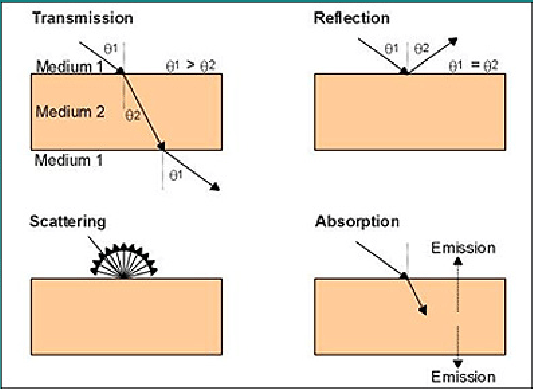Interactions
The way electromagnetic radation interacts with matter can be detected with different sensors. How the radation interacts depends upon the properties of the medium, the wavelength of the incedent radation and the incident angle. There are four major types of interactions that occur: transmission, reflection, scattering and absorption (Lillesand and Kiefer, 1994).

www.gi.alaska.edu/~prakash/teaching/undergraduate/material/lecture2
The atmosphere also has interactions
with electromagnetic radiation as it passes through the atmosphere. Atmospheric
scattering occurs when electromagnetic radiation entering the atmosphere interacts
with particles in the atmosphere and the direction of the energy change is
not predictable (Prakash, 2002). There are three major types of atmospheric
scattering which are dependent on the wavelength of radiation and the size
of the atmospheric particles.
Rayleigh scattering is the most common type of scattering and occurs when
the electromagnetic radiation is much larger than the particles in the atmosphere.
Rayleigh scattering occurs in the blue section of the electromagnetic spectrum
and is the reason that the sky appears blue (Prakash, 2002).
Mie Scattering occurs when the wavelength of the incoming electromagnetic
radiation is comparable in size to the atmospheric particle. Mie scattering
occurs in the red and orange parts of the spectrum and explains why the sky
appears orange and red at dusk and dawn. The water vapor and fumes in the
atmosphere cause the electromagnetic radiation to scatter(Prakash, 2002).
Non- Selective Scattering occurs when the wavelength is smaller than the particles
in the atmosphere. Non-selective scattering affects all of the parts of the
spectrum equally and explains why clouds appear white. White clouds are a
result of all of the visible wavelengths being scattered equally (Prakash,
2002).
Detection of Electromagnetic Radiation
The radiation that is emitted reflected or scattered from a body generates a radiant flux density in its surrounding space which contains information about the bodies properties. To measure the properties of this radiation a collector and detector are used. The collector is a collecting aperature which intercepts the radiant field and focuses the energy into a detector. The collector for viisual, infrared and ultraviolet remote sensing is usually a lens or a reflecting surface. The detector then transforms the electromagnetic radiation into another form of energy such as heat, electric current or state charge (Elachi, 1987). These forms of energy are measured and converted into digital numbers that can be transformed into images that can be processed.